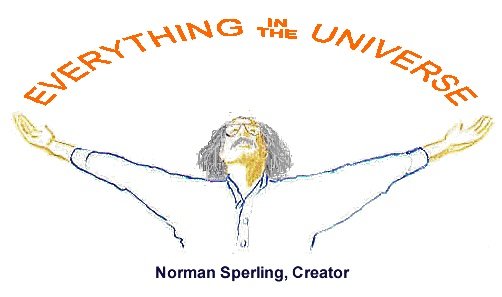Books on Space Law (back to 1959!) and Space War (back to 1962!) posted in “My Library is for Sale” November 2025.
I was interviewed about Astroscans, and a little about my wood-bound Dobsonian book, for the Astronomy Garage podcast by John Dreese. 1h 37m! https://youtu.be/7WXJMSK3F1c
- — < ◊ > — -
—> Formatted for desktop screens; server scrambles segments for mobile devices. <—
Smarts and smiles! This website rewards time and thought with original ideas and products. Everything here is by and for real humans. Nothing here is mentioned in, or described by, Cory Doctorow’s Enshittification. Not for “tl;dr” simpletons; suckers seeking instant oversimplifications should retreat back to the rest of the Internet. No artificial intelligence hallucinations, no loyalty bribe, no app.
Email: normsperling@gmail.com Postal: 2625 Alcatraz Avenue #235, Berkeley, California 94705 USA.
- — < ◊ > — -
NEW CHART UNIFIES STARS AND SOLAR SYSTEM
All Cosmic Bodies™,
From Meteorites to Stars,
Are Actually Cousins
© 2025 Norman Sperling
For the first time, you can understand the Solar System as a family of cousins, not a sideshow of freaks.
Space Age research reveals that stars, planets, moons, asteroids, comets, and meteorites each clumped from a cold nebula … heated … stirred … and banged around. Each clump’s mass determined how hot it got; closeness to the Sun helped. Each clump’s peak core temperature determined what processes it went through, its inside and surface structure, and how it looks now. Mass + Heat → Destiny.
Novel breakthrough! Graphing mass versus heat reveals sensible relationships and categories, which I color-coded. I converted mass measurements from “Earths” and “Suns” to kilograms. I sought best estimates of core temperature, since that’s not yet measured directly.
From least massive to most:
Purple: Chips land on Earth as meteorites.
Blue: comets have surface ices, no matter what’s beneath.
Orange: asteroids and small moons hold uneven shapes.
Green: crusted spheres pull themselves round.
Yellow [brown in the paper pasteup placeholder]: substars can’t fuse hydrogen …
Red: but stars do.
The antique term “planets” overlaps the largest crusted spheres and the smallest substars.
Pictured: Paper pasteup placeholder. Artwork in progress.
This colorful graph will come in 2 versions:
• A free single-page download .pdf, 978-0913399-41-5 (you’re welcome to download this placeholder if you can’t wait for the improved graphics.)
• And a glorious 24 x 36-inch poster, almost 10 times bigger, with thrilling photos of the bodies in space, and telling richer explanations and background. Buy the enriched poster version soon. 978-0913399-42-2. BISAC SCI 004000 astronomy. Product code BODS.
Great for the science-literate public, especially astronomers, educators, hobbyists, past and present astronomy students, planetaria, model solar systems, and more.
Advantages Over Antiquated Heritage Categories
SINGLE POSTER
PAGE
✅ Free
✅ ✅ Plots all bodies on the same scales
✅ ✅ Unifies everything to the Metric System
✅ ✅ Mass and temperature mark off categories
✅ ✅ Color coded classes: stars are red, ices are blue
✅ ✅ Doesn’t force gases and solids into the same category
✅ ✅ Plain-English concepts evade technical terms
✅ ✅ Shows that layering by density is a major process
✅ ✅ Clarifies most meteorites as fragments of asteroids
✅ Glorious images of heavenly bodies
✅ Exposes Heritage categories’ flimsy standards
✅ Enriched explanations
✅ Shows that heat and pressure strengthen solids
✅ Nature’s narrow criteria for volcanoes and tectonics
✅ Chart: where elements come from
Advantages Over the Hertzsprung-Russell Diagram
✅ ✅ Stars relate to planets, comets, asteroids
✅ ✅ Temperature increases to the right, not the left
✅ ✅ Core temperature is more important than surface’s
✅ ✅ Mass is much more fundamental than luminosity
✅ ✅ Undistracted by “magnitude’s” backward 5th-root-of-100 ratio
✅ ✅ Stars evolve straight right, not helter-skelter
points to ✅ Where neutron stars fit
The Free Single-Page version will be a downloadable .pdf. We invite and permit people who do, teach, study, communicate, or facilitate Science to copy that version for free, if credited to “© 2025 Norman Sperling, EverythingInTheUniverse.com. All rights reserved.” All other users and uses: request from normsperling@gmail.com.


